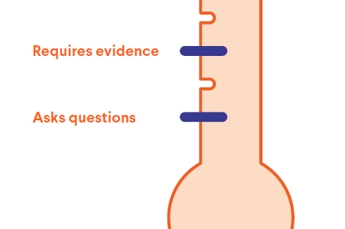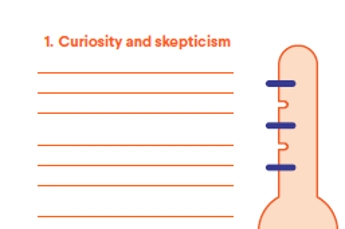Foster STEM dispositions
A key contributor to success in STEM is a growth mindset, but studies have shown that many girls hold a fixed mindset (a belief in innate ability) when it comes to STEM.
STEM dispositions are strongly related to having a growth mindset.
STEM dispositions are the attitudes and states of mind that support students to achieve success in STEM education and to pursue STEM career pathways. These dispositions are made visible through demonstrated behaviours. The STEM dispositions are:
- Curiosity and scepticism – students are curious about phenomena; they question ideas and seek evidence
- Collaboration – students value others’ contributions
- Creativity – students generate new ideas and approaches
- Persistence – students overcome obstacles and stay focused
- Problem-solving – students understand the problem from multiple perspectives and consider a range of approaches and solutions
- Intellectual risk-taking – students contribute ideas, questions or creative thoughts, even when they might be perceived as incorrect or naive by others
- Making connections – students search for relationships between ideas, approaches or phenomena
In your classroom: Identify dispositions and their supporting behaviours
Consider how you explicitly or implicitly value the STEM dispositions in your classroom. What evidence would students use to interpret your beliefs and values?
Use this poster as a talking point in your classroom or to guide students’ self-reflections on their STEM dispositions and skills.
Use the STEM dispositions snapshot to explore how students rate their own readiness to enact each disposition and provide opportunities for students to journal about their experiences.
Use the STEM dispositions poster as a visual tool in your classroom to highlight examples of students demonstrating high levels of skill or invite students to push themselves to increase their level on the meter.
Work with your students to create group STEM disposition posters. Encourage students to create their own images and text. Use these posters to highlight examples of students demonstrating high levels of skill or invite students to push themselves to increase their level on the meter.
Classroom talk tips
- Model curiosity by wondering out loud about phenomena or ideas.
- Broaden students’ ideas about what counts in STEM, by valuing and rewarding not just right answers, but student contributions that demonstrate curiosity, scepticism, creativity and intellectual risk-taking.
- Link students’ dispositions to thinking like a relevant STEM practitioner, for example, ‘What a great thing to wonder about, Sam! I love your curiosity; you’re really thinking like an engineer.’
- Actively embrace and celebrate confusion and disagreements as crucial moments in learning, for example, ‘I see that we have a range of ideas about what’s happening here. Excellent! Let’s work through these different perspectives to build our understanding.’
- Talk about failure and setbacks when they occur, honouring the emotions associated with struggle, and the value of persistence in the face of obstacles.
- Notice and acknowledge perseverance and effort in reasoning and sense-making rather than just the outcome, for example, ‘Lisa, I can see all the different ways you’ve tried to solve this and the way you’ve connected these ideas. That shows fantastic thinking and persistence.’
- Explicitly teach students how to respectfully disagree, for example, by modelling sentence stems, such as ‘I respectfully disagree with … because I think …’ or ‘I like your ideas, but…’
- Model and explicitly teach students how to ask questions to understand another person’s perspective, for example, ‘Can you tell me more about …?’ , ‘What do you mean by …?’ or ‘Could you please explain …?
Find out more:
To learn more about how educators can work with students to understand the concept of a growth mindset, explore the What’s the context section of the GiST.
Take a look at the next GiST Talk approach, 3. Value students' STEM knowledge and experiences
Resources

STEM Dispositions Meter Posters
Use the STEM Dispositions Meter Posters posters to highlight examples of students demonstrating high levels of skill or invite students to push themselves to increase their level on the meter.
Download
STEM Dispositions Snapshot
Use the STEM Dispositions Snapshot to explore how students rate their own readiness to enact each STEM disposition.
Download









